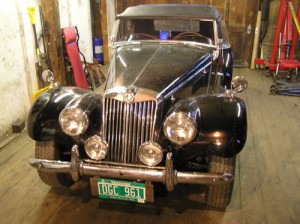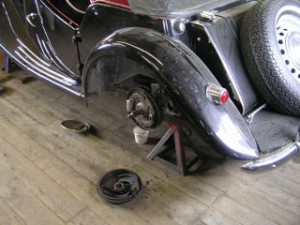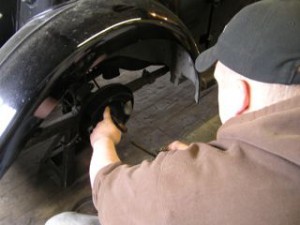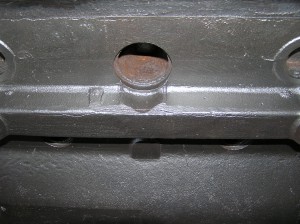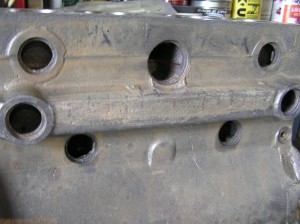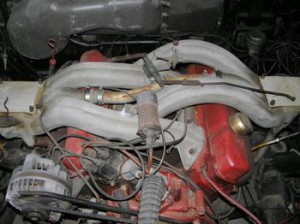A year or two ago this MG TF showed up here with a valve thru a piston, so we had a valve job done and tossed in a used set of pistons and a used cam*. Now it runs great. It’s here right now for its periodic check up. We replaced the rack boots, counseled the owner to hold steady on the steering rack for the time being, and also tended to a leaky left rear wheel cylinder.
The leaking wheel cylinder kinda’ pee’d on the brake linings a bit. This particular style of Lockheed cylinder, with a handbrake lever acting thru a slot on a mechanical slave piston in the top of the bore doesn’t hone very well. Well, you can hone it, at a rough cost of one brake hone per cylinder, so we just replace ’em. It’s cheaper. Because the right hand brake assembly was O.K. for now, we did a little shuffle.
Rather than install a new set of brake shoes for $65.00, we elected to equalize the rear braking by shifting both left rear shoes to the “trailing” position, which is at the top on a TD or TF. The direction of the moving wheel cylinder piston is downwards into the path of rotation, which makes the lower shoe the “leading” shoe, and also creates the “self-servo” effect which reduces pedal effort in a car with drum brakes. Sometimes we’ll get in a TD or TF with the front wheel cylinders reversed. These cars have great braking efficency backing up, but are a real handfull moving in a forward direction.
Around the same time we were cleaning up the used parts shelf to the benefit of the TF, we had a long dormant TD engine delivered to us for overhaul. Once we got it cleaned up (the casting was baked to carbonize 50 years of sludge, and then run thru a steel shot cabinet), we found this particularly nasty water jacket crack. Back in the day you might have tossed it on the metal pile and found another one, but that luxury is long past.
Now we have to fix ’em. Enlarge this picture and take a look. We’ve had the crack repaired by a process known as “cold pinning”. It works roughly like this: a hole is drilled at each end of the crack as a “stopper”, threaded, and filled with a cast iron dowel. Then another hole is drilled partially overlapping the first, and threaded & doweled again, until the crack is completely filled. If you look closely, at roughly one inch intervals the pinning is reinforced perpendicularly. Because heat isn’t involved, new stress cracks common to weldng don’t develop. Once the paint went on, it was never to be seen again.
Now just to see if anyone’s still paying attention, the first three people who can identify this intake set up will receive a free oil filter for their british car.
*The Asterisk: The used cam mentioned in the first paragraph came out of an amateur restored TD, and proved once again how a little knowledge can be a dangerous thing. Because the cylinder head had been skimmed several times and there was insufficient clearance for valve adjustment, instead of buying shorter pushrods or rocker pedestal shims, or both, the owner simply fired up his lathe and made his own set of tappets… with disasterous results. Because they wern’t heat treated, they quickly failed and sent shrapnel absolutely everywhere inside that engine. Many thousands of dollars later when we were I.S.O. a servicable used cam for the TF, we took another look at the one from the wreckage and discovered the tin coating polished right off. Et Voila ! One man’s folly became another man’s serendipity.

